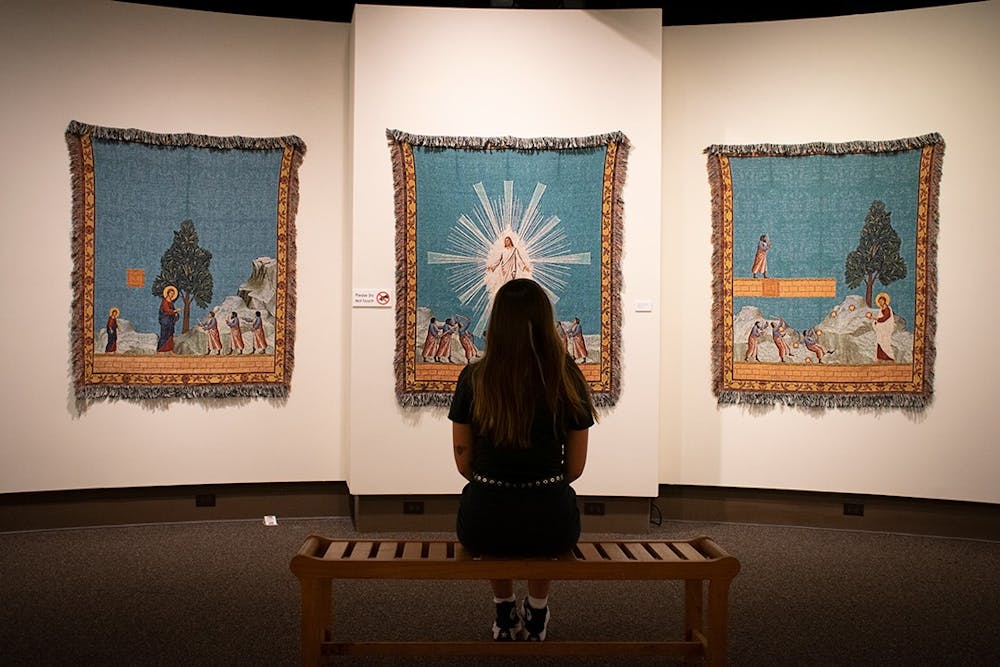The McKissick Museum, a University of South Carolina nonprofit institution, takes patrons on a journey of historic objects, from fossils to a first-generation iPhone. This historic, on-campus experience begins in its modern display of evolution, located in the lobby of the visitor center, complete with a display of USC’s mascot.
The McKissick exhibits, “The Shell Game" and “Carolina Knives,” are on display until December showing Carolina's natural history and the passed-down art of knife making. Another exhibit, “Hyphen-ated,” presents the works of Dan Hernandez and Arturo Rodriguez, two art professors from Ohio, who incorporate history, religion and pop-culture media. These artists will be featured and are available to speak to visitors in the closing ceremony on Oct. 22.
Upcoming exhibits include “Outsider Artists,'' which will be on display starting in November, until March 2022. This curated exhibit will specialize in art history and feature non-traditionally trained artists who come from various minority communities, all from a time where traditional art wasn’t available to them.
Giordono Angeletti is the curator of these exhibitions and is in charge of gathering artifacts or, as he likes to call them, "just a couple of old things."
“We try to present different aspects of what a museum can do," Angeletti said. This includes a responsibility to "bring up relevant conversations."
The McKissick Museum also has digital exhibits from when the university closed due to COVID-19. Curators used the closure as opportunity to create interactive exhibits.
In this modern evolution of the museum, visitors can be immersed into the history of the artifacts as they can watch their various functions in non-traditional ways. For example, a typical glass case wouldn’t allow patrons to hear an Obama bobble-head speak or hear the squeak of George H. Bush’s dog toy, but this digital exhibit has extended the ability of its artifacts.
“We wanted the collections to be something people could keep on visiting even after we’ve pulled it down,” Angeletti said.
As preservation is the goal of the collection, objects are unable to stay on display for long at the museum, because the light, humidity and stress will affect their preservation overtime. After they’ve been on display for six months, they have to rest for three to five years.
“The McKissick really exists to preserve objects into the future,” Christian Cicimurri, the curator of collections, said. “Whether those objects are currently borrowed from artisans or have been literally dug out of a dusty box in the depths of an archive building, there’s really something to learn about all of the objects.”
A unique feature of the collection is the broad variety of pieces due to the safeguarding-nature that people see the museum for. Many give donations and collections to the university because of its long-standing establishment.
“The university was an institution that people thought would last in time,” Angeletti said.
Before the founding of the state museum and library, the university was a safeguard of South Carolina history for almost 200 years. During this time, USC was the recipient of chairs from historic South Carolina governors, canons, a machine gun donated by Douglas MacArthur, a bust of Adolf Hitler from WWII and other objects made of silver, quilts and textiles.
When receiving new objects, curators are conscious and willful of what they collect. Today, they go through a research process to try to understand how objects will enhance the mission of the museum. Curators are then assigned themes that correspond with their interests.
“Every time you have an exhibition you have to study, become an expert on that topic,” Angeletti said. “It takes a lot of work before you can actually put anything on the wall.”
The curators' area of expertise have to do with where they're from and what they've studied. The McKissick Museum has curators from all over the world who create these exhibits and their work reflects their background.
Jane Przybysz, who has been the executive director of the McKissick Museum for 11 years, came from California where she worked as a director of a textile museum.
Przybysz said the mission of the McKissick Museum is to tell the story of southern life, community, culture and the environment.
“I’m really proud to be part of the McKissick Museum, of the University of the South Carolina and of the group of museum professionals that chose to be in the South despite the fact that our colleagues think we’re a little crazy,” Przybysz said.

